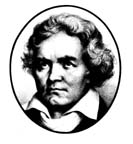Composer Example: Beethoven
We have produced a 312 page book that covers 17 of the greatest classical keyboard composers in history. For each composer we give a historical sketch of the composer, commentary on their style, commentary on their more important works and sample sheet music they have produced. We follow this with a comprehensive list of all their works so if you like what a composer is like you can instantly go order some or all of their sheet music.
In this discussion, we will give you a sample of the presentation we do for each composer.
Ludwig van Beethoven
Baptized in Bonn, Germany,
Historical Sketch
Beethoven’s genius survived an abnormal childhood ruled by a despotic
father. Johann Beethoven demanded hours of daily piano playing from his son
and often waked him in the middle of the night for further practice. The
only softening influence in the home was provided by Beethoven’s gentle and
affectionate mother. At 11, after lessons with various undistinguished
teachers, Beethoven came in contact with the organist and pianist Christian
Neefe, a thorough musician and enlightened teacher. Requiring Beethoven to
study Bach’s
Well-Tempered Clavier,
Neefe laid the musical foundation which enabled Beethoven to win the
admiration of later Viennese audiences. At 13, Beethoven became
harpsichordist in the Court Theatre Orchestra. The following nine years saw
his mother’s death, his father’s decline, and his own assumption of family
responsibility. His father’s influence disappeared, and he was able to
transform youthful misery into an enduring crusade for freedom and
self-respect. His active musical life included appointment as violist in the
Bonn Court Chapel and Court Theatre. Here he associated with established
musicians at the center of Bonn’s intellectual and social life.
Count Waldstein, an influential member of royalty and Beethoven’s life-long
friend, was decisive in Beethoven’s moving to Vienna in 1792. At 22,
Beethoven was already a recognized virtuoso pianist whose ability Mozart
prophesied would bring Beethoven world recognition. Beethoven arranged to
take lessons with the elderly Haydn. But his uncompromising ideas kept him
from accepting Haydn’s method of teaching, and the lessons generally were
not successful.
Except for Haydn and Mozart, few musicians at the start of Beethoven’s
career acknowledged his genius as a composer. His often violent expression
of emotion was unlike anything previously composed; his novel ideas coupled
with fierce independence of temperament cut him off from immediate public
acceptance.
A few years after his arrival in Vienna, he began to appear in concerts as a
composervirtuoso, and in 1796 his three
Sonatas of Op. 2
(dedicated to Haydn) were published commercially. His integrity made him a
favorite among families of nobility whose names appeared frequently in his
dedications, Count Waldstein, the von Bruenings, Prince Lichnowsky, and the
Archduke Rudolph. Rudolph became his greatest patron and in 1809 signed an
agreement to make annual payments to Beethoven provided he lived in Vienna.
Beethoven left Rudolph an overwhelming legacy of dedications which include
Opp. 58, 73, 81a, 96, 97, 106, 111, 133, and 134.1
When he was 30, Beethoven began his greatest compositions. This period also
marked the onset of deafness which in time became complete. As he himself
revealed in the Heiligenstadt Testament,….
Style
A facet of Beethoven’s greatness was the translation of idealism into music
with daring musical innovations which depicted struggle and exalted beauty.
Its finest pianistic expression came in the
Sonatas
which show the entire development of his genius up to the last
String Quartets.4
Consistently superior in architecture, emotional range, and innovation
without repetition, Beethoven’s
Sonatas
surpassed all previous works in this form.
The ways Beethoven developed the
Sonata
were complex. He explored the smallest segment of each theme, producing an
endless variety of musical ideas. He employed contrast of key, a cornerstone
of sonata form, in surprising and unconventional ways, and introduced an
irregular number of movements as needed for expressiveness — two, three, or
four. At the end of movements he expanded a familiar closing device, the
Coda,
which in his hands became a further commentary on preceding material or the
introduction of an entirely new thought. Beethoven’s general technical means
were varied and original. He used massed chords as melodic phrases and
produced unprecedented power by adding the damper pedal to chordal sound…..
Compositions
The three periods in which Beethoven’s Sonatas are commonly grouped are
defined by the dates: 1795-1800, 1800-1814, and 1816-1822.5 The works of the
first period
(Opus 2 to 22)
follow rules of the sonata as developed by Haydn and Mozart. They contain
the only traces among Beethoven’s
Sonatas
of virtuoso display for its own sake, but as in the
Pathétique of Op. 13,
they foreshadow the inner drama of the later periods.
Sonata Op. 13 in C minor
(Pathétique) (1798)
Dedicated to Count Carl Lichnowsky The Pathétique Sonata, written four years before the Heiligenstadt Testament, expresses Beethoven’s awareness of advancing deafness. Beethoven’s own description, Pathétique, apples to the Sonata from the passionate slow Introduction of the first movement Allegro, through the.....
Lots more…….More
about the publication, including reviews by major magazines and sample pages
from the book can be found by clicking here:![]()




